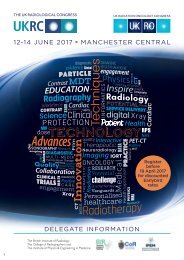Towards Safer Radiotherapy
Towards Safer Radiotherapy
Towards Safer Radiotherapy
You also want an ePaper? Increase the reach of your titles
YUMPU automatically turns print PDFs into web optimized ePapers that Google loves.
2.3.3 There was an average of 30 incidents reported per year from the 60 radiotherapy<br />
departments in the UK; that is, an average of three reported incidents per department<br />
during 2000–06.<br />
2.3.4 One incident was an underexposure and as such there was no legal requirement to report it.<br />
2.3.5 Three incidents involving the unintended exposure of a foetus throughout a radical treatment<br />
course also did not technically need to be reported, as protocols were in place and had been<br />
followed. In each case, it had been documented that before treatment the patients had been<br />
asked their current pregnancy status and advised they should avoid becoming pregnant during<br />
treatment. In each case, the patient failed to disclose her pregnancy to treatment staff.<br />
2.4 Analysis of incidents reported under IR(ME)R in England, Scotland and Wales<br />
2.4.1 A number of key features should be noted.<br />
• All reported incidents were investigated by the appropriate IR(ME)R authority.<br />
Subsequently, the healthcare organisation was required to put systems in place locally to<br />
minimise the risk of such an event occurring again.<br />
14<br />
• In about 80% of the 181 cases, the patient was not expected to suffer any adverse clinical<br />
effects from the error.<br />
• Three incidents occurred as a result of a patient not being identified correctly on one<br />
single visit (fraction) for treatment, which was part of a longer course.<br />
• Four incidents involved systemic failures that affected the treatment of more than one<br />
patient. The numbers of patients who potentially could have experienced adverse clinical<br />
effects due to the error were four, 11, 14 and 132 patients respectively. In all cases the<br />
clinical impact of the errors was small.<br />
• Over 90% of incidents were attributed to an error in carrying out a practical aspect of the<br />
treatment design, preparation or delivery.<br />
• The other 10% occurred as a result of a failure to supply correct details at referral or an<br />
incomplete or erroneous treatment prescription.<br />
2.4.2 Two examples of incidents that have been reported and investigated under IR(ME)R by the<br />
appropriate authority are described briefly in Table 2.4.<br />
<strong>Towards</strong> <strong>Safer</strong> <strong>Radiotherapy</strong>



